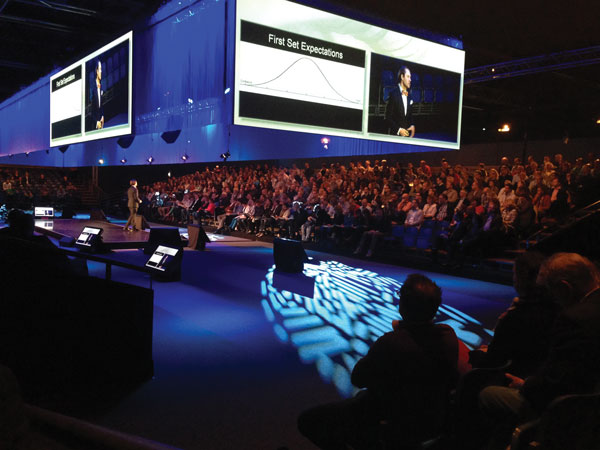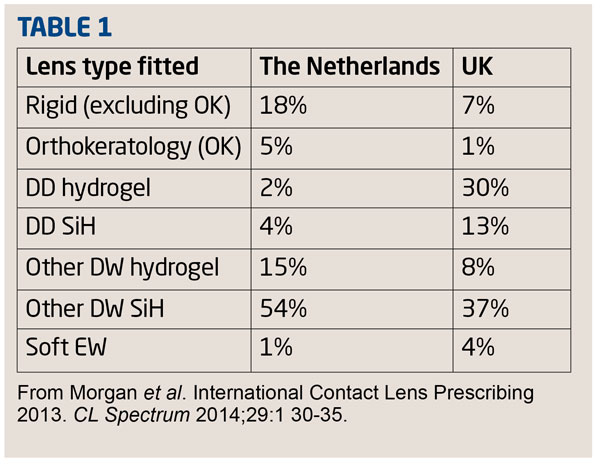Holland may be one of the UK’s nearest neighbours but in contact lens prescribing the two countries are very different. Almost one in four contact lenses fitted there is a rigid lens and fewer than one in 10 soft lenses is a daily disposable.
The Nederlands Contactlens Congres (NCC) reflects the unusual nature of the Dutch market, with sessions on ortho-K, scleral lenses and custom design, and more emphasis on contact lens fitting techniques than most meetings.
With nearly 1,600 delegates travelling to Eindhoven for this year’s event, including an estimated three-quarters of all contact lens fitters in the Netherlands, the formula clearly works.
‘Decoding the secret’ was the theme for NCC2014 (March 16-17), with parallel tracks of lectures, company presentations and workshops. An excellent exhibition featured local labs and equipment suppliers alongside more familiar manufacturers.
Above all, the organisers aim to make the meeting enjoyable, with plenty of opportunities to network with colleagues and informal social events.
NCC is also famous for its presentation style, which this year featured a 360° podium with the audience on all sides and a ‘speed-dating’ session allowing delegates two minutes to put their question to each speaker.
So what was there to learn? With the focus more on education than research there was plenty to take home and apply in practice. More lectures, and most of the specialist lens presentations, were in Dutch, so the small UK contingent were restricted in their options.
Data differences
International prescribing rates may be of only passing interest but, as Professor Philip Morgan (University of Manchester) explained, what practitioners are fitting today industry will be selling in 1-2 years’ time. His group’s annual surveys have recorded contact lens fits in 54 countries and reveal some startling differences in fitting habits.
What made the Netherlands unusual was the high rate of RGP prescribing and one of the lowest uptakes of daily disposables in the world. It was practitioner attitudes rather than patients’ needs that differed between neighbouring countries, which showed how important the professional was in controlling the market, he said.
The proportion of soft lenses fitted in Holland that were toric was close to the prevalence of astigmatism of =0.75DC in one or both eyes (47 per cent). Recent uptake of torics in many markets was ‘a big success story for the contact lens market’. Less successful were multifocals, which fell well short of desired prescribing levels.
A patient aged 20 was 40 times more likely to get a proper contact lens correction for their refractive error than was a 60-year-old, said Professor Morgan. There was also a shortfall in the use of contact lenses for children and teens, with only about 10 per cent of fits over the past 10-12 years to under-18s.
Jason Nichols (Ohio State University) reported trends in the world’s largest contact lens market, the US, where daily disposables historically lagged behind most countries. These lenses now accounted for around 20 per cent of the US market and there had been a shift from two-weekly to monthly reusable lenses.
A rumoured resurgence of interest in extended wear in the US, following an advertising campaign by one of the major manufacturers for a lens approved for this modality, was yet to be reflected in fitting trends.
The Dk/t debate
Packed lecture halls for a session on ‘Decoding the secret of oxygen’ and a company presentation that followed showed that the oxygen story is not yet over. Standing in for absent keynote Ken Polse, Professor Morgan explained the background to the Dk/t debate. The crux of the argument remains how much oxygen is enough for daily wear and extended wear of a soft lens, and whether that lens should always be a silicone hydrogel.
Noel Brennan (Johnson & Johnson) argued that the law of diminishing returns applied to Dk/t. For daily wear, the minimum Dk/t required was 20 for the central cornea and 30 for the periphery. For extended wear, a Dk/t of about 50 would allow the cornea to consume oxygen at 95 per cent of its normal amount over the course of 24 hours.
If all SiH materials were above Dk/t 50 did it matter which one we choose? Not for daily wear, said Dr Brennan. Yet SiHs had failed to decrease rates of microbial keratitis in either daily or extended wear, and overnight wear remained the biggest risk factor.
Studies consistently showed double the rate of infiltrative keratitis with SiHs versus hydrogels, for either modality. Daily disposables showed very low rates; in fact the latest study found no corneal infiltrative events in 471 patient years with daily disposable hydrogel lenses.
SiHs were preferred for extended wear, although both types of material had their advantages for daily wear, and daily disposables were preferred overall. ‘Don’t always go straight to a SiH. Fit the right patient to the right lens, and remember that comfort is key. It’s all about the balance of properties,’ he said.
In a presentation for Alcon, Eric Papas (Brien Holden Vision Institute) argued that the importance of oxygen was due for reconsideration. Improved corneal oxygen modelling showed that, in the open eye, a Dk of about 20 was enough to prevent stromal anoxia in the central cornea but the peripheral cornea had the potential for significant hypoxic stress and needed a Dk of around 200 to avoid stromal anoxia. In the periphery and in the closed eye, it was normal to be anoxic. A high Dk enabled the eye to return to a ‘normoxic’ situation more easily on eye opening.
Peripheral transmission influenced redness in the underlying limbus. Avoiding limbal redness altogether required an average Dk of about 125. ‘The higher the better, but a value of around 55-56 is the minimum we should be thinking about using,’ he said.
The relationship between comfort and oxygen had not been well investigated, although one study showed longer comfortable wearing times when patients were refitted from hydrogel to SiH daily disposables.
Modern high Dk lenses have eliminated many problems. But for Papas, approximating ‘no-lens behaviour’ required higher transmissibility.
The lost art of soft lens fitting
Among other topics, a series of presentations on soft lens fitting proved especially popular. For these speakers, poor fit was implicated in dissatisfaction with soft lens wear and was a factor in dropout. A call for manufacturers to produce a wider range of parameters was loudly applauded.
Mark Andre (Pacific University Oregon) looked at the role of corneal diameter in soft lens fitting. As lenses became more and more disposable, it became almost impossible for manufacturers to add more lens parameters. But were practitioners accepting a low success rate because of a lack of diameters?
Andre categorised corneas into small (=11.3mm), medium (11.4-12.2mm) and large (=12.2mm). Medium corneas were easiest to fit, but a large cornea with a very deep sagittal height might need a custom-made lens to achieve a good fit. In fact 17 out of every 100 patients would most likely benefit from a custom soft lens diameter.
Eef van der Worp (University of Maastricht) said changing base curve while keeping the diameter the same had much less effect on sagittal height than increasing diameter with the same base curve. Practitioners needed to start thinking in sagittal heights to better understand lens behaviour.
Marco van Beusekom (J&J) pointed to a new study of factors involved in symptoms with SiH lenses which showed that excessive lens movement and inferior decentration were associated with discomfort and dryness.
Assessing presbyopes
A session on presbyopia yielded some useful tips for different ways of assessing visual performance in presbyopes. Professor James Wolffsohn’s group (Aston University) had developed a 10-item questionnaire to assess the relative subjective benefits of presbyopic corrections. Speed of reading was among the measures for comparing performance.
This group was also working on tablet-based tests where the patient could draw the outline of a contrast sensitivity function on the screen, and take a glare test that simulated night driving conditions.
Professor Wolffsohn said he did not find ‘huge differences’ between the multifocal lenses currently on the market but there were intraocular lens options using refractive, diffractive, segmented and light-adjustable approaches to correct presbyopic. One solution more common in surgical correction was to mix and match different approaches, such as a diffractive IOL in one eye and a refractive IOL in the other.
Practical advice came from David Kading (Optometric Insights, Seattle), who shared his ‘Five secrets of presbyopic success’.
Rub or no rub?
Presentations on solutions provided a catch-up on lens care developments over the two years since the last NCC, covering dual disinfection systems, microbial efficacy, rub and rinse, and solution-induced corneal staining.
Lyndon Jones (University of Waterloo) mentioned the 2013 study by de la Jara’s group investigating the effect of lens care systems on the clinical performance of contact lenses. Regardless of solution used, senofilcon A lenses did not perform as well when used on a reusable basis as when used on a daily disposable basis.
The same group looked at the performance of various lenses and lens/solution combinations based on the combined response of subjective comfort and adverse events. The combinations with the best comfort ratings did not necessarily have a favourable adverse event rate.
Reviewing the rub and rinse story, Greg De Naeyer (Ohio State University) observed that Bausch+ Lomb’s new hydrogen peroxide system, PeroxiClear, launched in the US last month, was for use with soft and RGP lenses and only required a four-hour disinfection cycle. Packaging insert directions were a rinse-only step for soft lenses, and no rub step, while for RGPs the directions were for rubbing, he said.
Myopia control
Two years ago, myopia control was top of the NCC agenda. This year there was less emphasis on the topic but a few interesting developments included a comment from Noel Brennan that J&J was ‘working towards production’ of a myopia control product and a report that CooperVision’s MiSight lens was now available in Europe.
Martin Loertscher, (Phillips’ laboratory, Auckland) described an approach combining ortho-K with dual focus optics. Compared to ortho-K, ‘multiple ortho-K’ led to a rapid and sustained decrease in vitreous chamber depth. With this technique, axial length was shorter at the end of the study than at baseline, not just slowing myopia progression but reversing it.
? NCC is organised by the NAC (Nederlandse Associatie van Contactlensleveranciers) and ANVC (Algemene Nederlandse Vereniging van Contactlensspecialisten). For more details visit www.ncc2014.nl. The next NCC takes place on March 13-14, 2016


